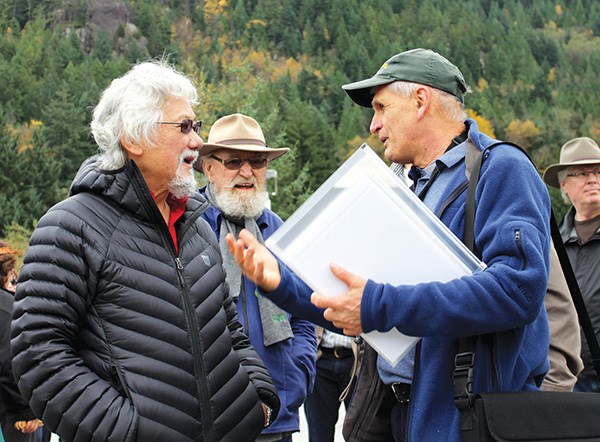Howe Sound is being used as a “garbage can,” David Suzuki told media on Saturday.
“We’re using it as a garbage can, and the consequences for whatever is in the oceans is catastrophic,” the renowned environmentalist said at an event held at Porteau Cove.
However, his Sept. 8 post on the David Suzuki Facebook page was more positive: “Did you know that Howe Sound was once declared a ‘dead zone’ because of industrial pollution? Now we’re seeing returning salmon, dolphins, seals and even humpback whales.”
On Saturday, Suzuki received a warm welcome from local First Nations and community groups at the event, which he attended in conjunction with the Blue Dot Tour, a series of speeches and appointments across Canada encouraging environmental action by Canadian residents.
The tour, organized by the David Suzuki Foundation, started in Halifax on Sept. 24 and finished in Vancouver on Sunday, Nov. 9. The aim was to encourage citizens to recognize and advocate for the rights of breathing fresh air, drinking clean water and eating healthy food — which First Nations groups around the world have prioritized for centuries, Suzuki said in his speech at Porteau Cove. He spoke alongside members of the Squamish Nation and other Coast Salish representatives to spectators on the pier.
“Our ultimate goal is to have the right to a healthy environment recognized in the Charter of Rights and Freedoms.”
The Canadian Environmental Bill of Rights (Bill C-634) is currently being discussed in the House of Commons and, if passed, would make protecting Canada’s environment a more substantial legal obligation.
Several local groups were represented Saturday at Porteau Cove, including the Marine Life Sanctuary Society, Coast Salish and Squamish First Nations, the Squamish Helping Hands Society and the Squamish Streamkeepers Society.
“It’s really a wonderful coming together of many people and many different groups. This is a real community and to have David Suzuki bring us all together, it’s like wow.” said Jan Hagerdorn, a Squamish resident and Islands Trust representative for Gambier Island. “We all have a common goal here. People care about the environment, clear water, clean air.”
Scuba divers from the Marine Life Sanctuary Society put on a display of animals from the waters in Porteau Cove. Society members set up several tanks containing a glass sponge, smaller fish and invertebrates such as anemones and sea peaches at an information booth to educate people about life beneath the surface of the ocean.
Jonn Matsen, Jack Cooley and Thor Froslev of the Squamish Streamkeepers Society had a chance to share a success story with Suzuki. Starting in 2005, the Streamkeepers helped the herring spawn return to Squamish by creating artificial spawning grounds on the pilings supporting the East Terminal Pier. They wrapped the creosote pilings in black plastic to provide a suitable environment for herring to deposit their roe.
“When they put the sawmill in, it started leaking wood-preservative and that started killing eelgrass beds. In the long term, the bark from the booms smothered the eelgrass beds. Basically from the end of the 70s, the herring were just gone,” said Matsen.
The presence of larger marine species is connected with the return of herring to the region. This past March, a pod of white-sided dolphins came up the Howe Sound and were pursued by orca whales into the Mamquam Blind Channel.
- With files from Squamish Chief staff




